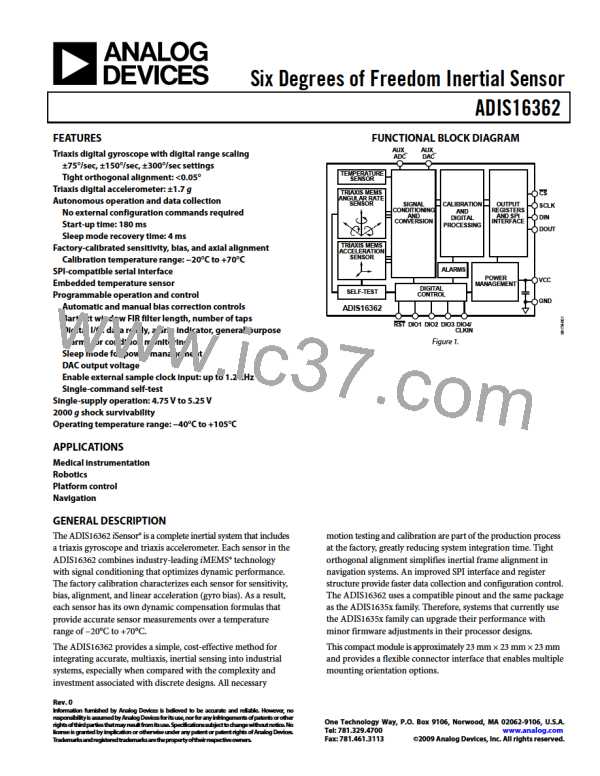ADIS16362
Table 27. ALM_MAG1, ALM_MAG2 Bit Descriptions
Table 30. Alarm Configuration Example 1
Bit
Description
DIN
Description
[±ꢀ]
Comparison polarity
(± = greater than, 0 = less than)
Not used
Data bits that match the format of the trigger source
selection
0xAFꢀꢀ,
0xAE±ꢁ
ALM_CTRL = 0xꢀꢀ±ꢁ
Alarm ± input = XACCL_OUT
Alarm 2 input = XACCL_OUT
Static level comparison, filtered data
DIO2 output indicator, positive polarity
[±4]
[±3:0]
0xAꢁ83,
0xAꢃ4±
ALM_MAG± = 0x834±
Alarm ± is true if XACCL_OUT > +0.ꢀ g
Table 28. ALM_SMPL1, ALM_SMPL2 Bit Descriptions
0xA93C,
0xA8BF
ALM_MAG2 = 0x3CBF.
Alarm 2 is true if XACCL_OUT < −0.ꢀ g
Bit
Description
[±ꢀ:8]
[ꢁ:0]
Not used
Data bits: number of samples (both 0x00 and 0x0± = ±)
Table 31. Alarm Configuration Example 2
DIN
Description
Table 29. ALM_CTRL Bit Descriptions
0xAFꢁꢃ,
0xAE8ꢁ
ALM_CTRL = 0xꢁꢃ8ꢁ
Alarm ± input = YACCL_OUT
Alarm 2 input = ZACCL_OUT
Rate-of-change comparison, unfiltered data
DIO2 output indicator, positive polarity
Bit
Description
[±ꢀ:±2]
Alarm 2 source selection
0000 = disable
000± = power supply output
00±0 = x-axis gyroscope output
00±± = y-axis gyroscope output
0±00 = z-axis gyroscope output
0±0± = x-axis accelerometer output
0±±0 = y-axis accelerometer output
0±±± = z-axis accelerometer output
±000 = x-axis gyroscope temperature output
±00± = y-axis gyroscope temperature output
±0±0 = z-axis gyroscope temperature output
±0±± = auxiliary ADC input
0xBꢃ0±
0xAB08
0xACꢀ0
SMPL_PRD = 0x000±
Sample rate = 8±9.2 SPS
ALM_SMPL± = 0x0008
Alarm ± rate-of-change period = 9.ꢁꢁ ms
ALM_SMPL2 = 0x00ꢀ0
Alarm 2 rate-of-change period = 9ꢁ.ꢁ ms
0xAꢁ83,
0xAꢃ4±
ALM_MAG± = 0x834±
Alarm ± is true if XACCL_OUT > +0.ꢀ g
0xA93C,
0xA8BE
ALM_MAG2 = 0x3CBE
Alarm 2 is true if XACCL_OUT < −0.ꢀ g
[±±:8]
[ꢁ]
Alarm ± source selection (same as Alarm 2)
Rate-of-change (ROC) enable for Alarm 2
(± = rate of change, 0 = static level)
Rate-of-change (ROC) enable for Alarm ±
(± = rate of change, 0 = static level)
Not used
Comparison data filter setting
(± = filtered data, 0 = unfiltered data)
Not used
PRODUCT IDENTIFICATION
Table 32 provides a summary of the registers that identify
the product: PROD_ID, which identifies the product type;
LOT_ID1 and LOT_ID2, the 32-bit lot identification code;
and SERIAL_NUM, which displays the 16-bit serial number.
All four registers are two bytes in length.
[ꢃ]
[ꢀ]
[4]
[3]
[2]
Table 32. Identification Registers
Register Name Address Description
Alarm output enable
(± = enabled, 0 = disabled)
Alarm output polarity
(± = active high, 0 = active low)
Alarm output line select
(± = DIO2, 0 = DIO±)
LOT_ID±
LOT_ID2
SERIAL_NUM
PROD_ID
0xꢀ2
0xꢀ4
0xꢀꢃ
0xꢀ8
Lot Identification Code ±
Lot Identification Code 2
Serial number
Product identification = 0x3F8ꢃ
(hexadecimal number for ±ꢃ,3ꢃ2)
[±]
[0]
Rev. 0 | Page ±ꢃ of 20

 ADI [ ADI ]
ADI [ ADI ]